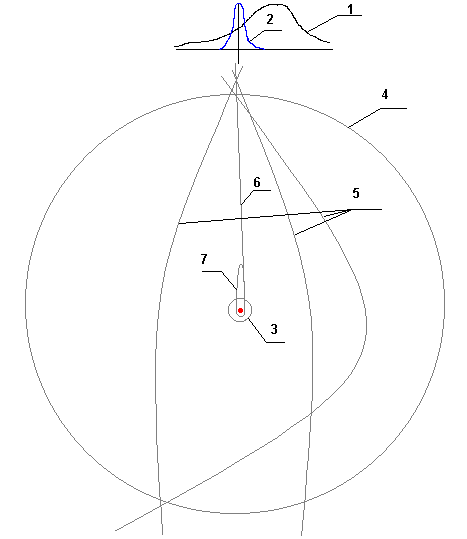
© Copyright - Karim A. Khaidarov,
November 5, 2004ORIGIN of the SUN and PLANETS
Dedicated to the bright memory of my daughter Anastasia
In this paper the concept and results of author’s research allowing to order the physical notions about physics of planetary processes are stated. There is shown, that the main building materials of stars and planets are interstellar gas, cosmic dust and cometary bodies. A new classification of celestial bodies is given. It is shown, that the time of evolution of celestial bodies was not billions, but trillions years. The alien stellar and interstellar origin of satellites of planets of a Solar system is discovered. The facts of existence of the Sun in a phase condition of a white dwarf up to the moment of collision of the Solar system with an alien planetary system of an infrared dwarf 4.56 billion years ago is discovered. The origin of Moon and meteoritic bodies is discovered too.
"I shall rescue him; I shall protect him, for he acknowledges My name"
[Psalm 90/91]
Based on discovered by the author during research of properties of aether the natural phenomena and regularities
[1-15], being grounded on Kant’s cosmogonic theory [16,17], and also using modern astronomical discoveries, let us consider the actual physics of celestial bodies of our planetary system and evolutionary path of the Sun, planets and their satellites, asteroids and comets, inevitably followed from this physics.However for clarifying the motivation of this research, we will consider a modern background in the theory of physics of planets, as far as the volume of this paper allows.
The Myths of Modern Astrophysics
"Who is this that darkens my counsel with words without sense?"
[Job. 38,2]
The majority of the existing theories of the origin of celestial bodies skips basic physical laws of conservation - weight, energy, momentum. The majority of “theories” enters in a straight line conflict both with physics of natural phenomena, and simple with logic. Besides they skip the laws of a thermodynamics and information theory (statistics).
The idea of equality of a specimen life expectancy and species time existence will not come in the mind of any biologist, historian will not say, that the life time of one man and mankind are values of a similar order. However such idea reigns in heads of astrophysicists. They count, that the life time of a planet is the similar order with life time of a star and life time of Galaxy consisting of 1011 stars, each of which lives by its personal life.
In violation of elementary logic, that anything can not occur from nothing, in the beginning of 20-th century the theory of “Big Bang” has appeared.
The absurdity of this idea is confirmed by numerous calculations of duration of life of stellar communities, for example, stellar spherical congestions. The life time of the ordinary star from infrared dwarf up to the blue giant and supernova explosion is possible to estimate about 1010 years by simple statistical count.
In spite of the fact that centuries ago great scientists M. Lomonosov, 1748, and. A. Loviesier, 1789, have proved the law of conservation of mass, and in spite of the fact that 250 years ago Immanuel Kant has described explicitly the process of origining of celestial bodies [16], and 40 years after Pierre Laplace "has updated" mathematically this theory [17], till now there are “theories”, which are based on physically impossible process of origin of asteroidal and cometary bodies inside a Solar system from nothing.
Contrary to the law of conservation of energy and momentum and laws of thermodynamics there are theories of matter erruption from a gravitational hole of the Sun into interstellar space and origining of mythic cometary clouds, which can not be steady and long-lasting, which existence does not confirm by any physical reasons.
For time and spatial scales of Universe and even of a separate galaxy the time period necessary for formation of a separate star is completely insignificant, and in this connection there would be reasonable to consider, that for the substance our time differs from the time of ten billions years ago both a little and process of stars birth and death goes in this scale practically stationary. That is protostars, young stars, the old stars coexist simultaneously. Another point is that astrophysicists do not see or do not want to see this reality.
The practical identity of an average elemental composition of the Sun, Jovian-type planets and interstellar environment on path of the Sun directly indicates that for billions years of existence of the Sun there was no visible consumption of material for a thermonuclear energy, that there is an actual denying of an actual role of thermonuclear reaction in a solar power. Almost half-centuries ago N. A. Kozyrev indicated [18] on that, and researches of present author shows, that the main (~99%) power source of the Sun and stable stars are given by energy of phase transition of an aether during a gravitation.
From archeobiological and geologic researches it is known, that during last 4·109 years the Sun practically has not changed the luminosity, that is its weight and chemical composition have not any essential change. However, 4·109 years ago there was an event breaking radically the appearance of our planetary system.
As will be shown below, from that moment too many evidences remained for precise reproduction of the script of this stellar catastrophe.
But in order to adequate perception of the set up concept at first we will consider process of arising of celestial bodies in a typical place of a typical galaxy (that is on orbit of our Sun) from a gas-dust mix before origin of modern protostar.
The Space Snow
Let's do not reason about unknown things, that is about epoch prior to the beginning of modern universe, that is before universe of stars and galaxies. While we have enough the base to suppose that modern universe exists many trillions years having practically immutable parameters.
Elemental composition of the Sun, chondrite meteorites, interstellar gas-dust mix and somewhat even the elemental composition of planets, changed by geological processes, tells that all celestial bodies were arising in unified process of an accretion of interstellar dust and gas.
According to Kant concept, which we will adhere and cautiously dilate in the light of astronomical data obtained during last 250 years, the elemental composition of interstellar environment is forming by explosions of supernovae and influx of hydrogen and probably helium from intergalactic environment.
The supernova explosions sputter sidereal material of the grown old stars on large distances, creating fields of cosmic dust and gas. The structure of this mix defined by long-lived evolution of a blasted star, nuclear-physical processes of explosion, and also intermixing of this material with ambient finely dispersed material of a galaxy, should be very stable. It confirms experimentally by comparising of elemental compositions of interstellar material, meteorites, planets and Sun.
It is known, that both in atmosphere of the Sun, and in interstellar gas-dust material the key elements are hydrogen (73.4 %), helium (24.9 %), oxygen (0.7 %) and carbon (0.3 %). It is natural, that at a contact the atoms of hydrogen and oxygen form moleculas of a water and hydroxyl group, and carbon and oxygen generate charcoal gas and carbonic acid. Besides the atoms of carbon are capable to incorporate with hydrogen, origining organic matters. These moleculas find out experimentally at research of spectra of comets and meteoric particles.
As is known, the moleculas of a water in conditions of a weak gravitation are capable to derivate very composite crystalline structures called snowflakes. Last, having a developed surface and ability to be moistened and to solve the majority of materials, imbibe practically all kinds of moleculas origined in space.
Thus in interstellar environment the particles of a composite elemental composition including gases, as the surface dissolved (adsorptioned) materials will be origined. Low temperature of interstellar environment contributes in holding even such volatile elements as hydrogen and helium.
Van-der-Waalse forces, surface force (wetting) and the dendrite structure of snowflakes contributes in their increase up to large snowballs, and then up to whole snow conglomerate - peculiar space “snow-men”. Exactly these “snow-men” are comets, which occasionally are watched by astronomers.
As more often phenomenon in high layers of the atmosphere, the separate burning snowflakes - meteors are watched, the rests of the broken comets or simple “microcomets” which have arrived from interstellar depthes of the Space.
The Proof of the Interstellar Origin of Comets
Contrary to a superficial conclusion of modern astrophysicists about “endemicity” of comets made by the form of distribution of its eccentricities (they speak: “if the comets have an interstellar origin, its eccentricities would be bigger than 1”), comet, as it was determined already centuries ago by great intellects – Johannes Kepler and Pierre Laplace, are interstellar objects.
When the adherents of “endemicity” of comets result as the proof the low eccentricities of comets (ellipticity of their orbits), they do not suspect about presence of following natural phenomena and effects.
1. Observability of comets. It is necessary to divide observable comets and unobservable, but obliged to exist by virtue of statistical properties of distribution of initial vectors of flow velocities of interstellar material. That is distribution of vectors at an entrance in a gravitational pit of the Sun.
The matter is in following. The comets become observable only at distances less than 5 a.u., when the sublimation of their material starts and a volumetric luminous tail were arised. If we consider that the radius of a gravitational pit of the Sun more than 2000 a.u. that at a symmetrical distribution of initial vectors of velocity only a few part of comets (less than 0,1 %) falls into a “core” of Solar system having radius 5 a.u. Remaining part leaves invisibly on hyperbolic trajectories back into interstellar environment, without any dissipation of its kinetic energy.
2. Tangential filtration. It is necessary to take into account, that in “core” of Solar system the comets having practically zero tangential speed of an entrance into a gravitational pit of the Sun fall only. At known speed of an interstellar flow of material 20 km/s relatively Sun only a few part of cometary bodies falls in this category, as “the tangential filter” cuts all excluding narrow band of distribution of a flow.
The experimental distribution of return eccentricities of observable comets displays it – the maximum of distribution places between 600 - 800 m/s and eccentricities are more than 1.
3. Ellipticity as an effect of a jet braking. It is necessary to take into account, that those comets, which fall in “core” of Solar system and observed there are comets which have dispersed (dissipated) its momentum, sufficient for transition into elliptical orbit.
Also it follows from simple reasons. The jets of gases, errupted by a comet during its evaporation (sublimation), are mainly directed on the Sun, that is these gases effuse from heated side of comet. This phenomenon easily decelerates the comet on several hundreds meters per second, sufficient for transition into elliptical orbit. Than comet is older, then the eccentricity of its orbit is less.
As a result of such changes the comet completely evaporates under operation of solar rays or significantly “dried”, having formed a shell consisting of high-melting components, passes into almost circle orbit and becomes one of satellites of planets if were not come in to collision with other celestial body.
The Origin of Protostars
In spite of protostars of mythical beginning of universe, physically real protostars start from small cometary bodies. Moving billions and trillions years in interstellar environment cometary bodies agregate under effect of gravitational forces into more and more massive bodies. Their density increases from 0.05 - 0.1 kg/dm3 up to 0.7 - 0.9 kg/dm3 at the cause of seal of cometary snow and transformation it into ice.
With increase of mass of a cometary body the escape velocity is increasing. It gradually changes a ratio of gas and condensed material. The part of hydrogen and helium more and more increases.
When mass of such body reaches to several masses of Jupiter, the phase transition of aether in gaseous component causes to an energy release, sufficient for heating and light emission of protostar at first in infrared, and then in a visible band. So protostar transforms into a ordinary optical star.

Fig. 1. The scheme of passing of cometary bodies through a gravitational pit of Solar system.
( 1 - general distribution of velocity of cometary bodies in circum-solar interstellar space with a maximum 20 km/s relatively the Sun; 2 - distribution of observable comets with tangential velocity less than 1 km/s, falling in a core of Solar system; 3 - core of Solar system with R < 5 a.u., 4 - gravitational pit of the Sun R > 2000 a.u.; 5 - hyperbolic unobservable trajectories of cometary bodies with tangential speed of an entrance in a gravitational pit more than 1 km/s; 6 – a trajectory of an entrance of a cometary body with low tangential speed; 7 – an elliptical trajectory of a comet after a jet dissipation of volatiles)
The Origin of Protoplanetary Systems
Up to achievement of mass, at which there are steady epicyclic niches, which origin is described in [13], protostar has no any steady and or large satellites. The eccentricity of comets falling in a zone of a dissipation, gradually drops up to zero. They collide with each other or fall out on a protostar.
However, in due course, the orbital niches become more strong. The cometary bodies of the same niche in due course inevitably collide, as their orbits are in essence intersected. So they will form a single body in each orbital niche.
The part of accretionable by satellites of protostar the interstellar material depends on numbers of a held niche, that is radius from protostar. Knowing relation of radius of a gravitational pit of protoplanet Rp on distance D between protostar and protoplanet is
|
R p = R0(Mp/Ms)1/3 |
(1) |
where Mp – is a mass of protoplanet, Ms – is a mass of a star, R0 = D/2 – is a half of distance between a star and planet,
The Titius - Bode Law for planetary niches [13] is
|
R i = 3Ro 2 i-3 +1, |
(2) |
where Ri - radius of i- niche, Ro - is radius of a zero niche (primary circulation of aether) [13],
and also from Galilean Law of acceleration of free fall, it is possible to find a statistical distribution of masses of protoplanet depending on their position in a planetary system.
Approximately, that is statistically average, without the couting of a random accretion of large bodies by separate protoplanets this relation for distant protoplanet will be
|
M p(i+1) = Mpi/3 |
(3) |
where i - number of a niche (planet).
The relation (3) does not take into account three important factors, which have large value for short-range to a star protoplanets:
It is easy to find the relation of a volatilization of light gases on distance up to a star from it temperature and Boltzmann distribution law for gases in atmospheres. With other things being equal, than the planet is closer to a star and than less planetary mass, then it is less the light gases in atmosphere of a planet.
The phenomenon of a classification of material on its density is stipulated by a different degree of effect on microparticles of a phase aether. For such light particles, as atoms of hydrogen and helium their dagging by aether is maximum. Falling in a gravitational pit of a star the atoms of these gases practically immediately lose a momentum (large eccentricity of particle’s orbit) and submit to common spiral flow of a phase aether. The heavy elements, particles of cosmic dust save the kinetic parameters so longer, than higher their density and mass. It allows them practically easy penetrate into central area of a gravitational pit of a star and to sink on the nearest planets.
Naturally, the gradient of an accretion of heavy elements depends on a star mass, as is a function of parameters of a gravitational pit. It is possible to express an approximate value of a density gradient for all total of nonvolatile materials for 3-rd and more distant planets, that is mass of planetary solid core, by simplified formula
|
M p(i+1) = Mpi/(0.75 lg(Ms) - 13.7) |
(4) |
where Ms – is a star mass [kg],
Mpi – is aa mass of i-planet [kg].
The Analysis of Parameters of Celestial Bodies of a Solar System
With the purpose of the analysis of an origin of celestial bodies of a Solar system the author collected the data about 80 bodies with known masses and sizes.
In a figure 2 the distribution of celestial bodies on density is shown.
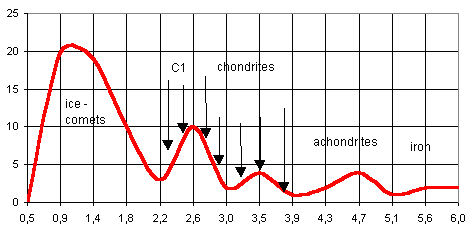
Fig. 2. Distribution of celestial bodies of Solar system on density.
As it is visible from the diagram there are clear separate clusters on density, on which it is possible to identify cometary-ice bodies with density lower than 2 [kg/dm3], carbonary chondrites, heavy chondrites, stony bodies appropriate on density to achondrites and celestial bodies with the large iron and nickel content.
In a figure 3 the relation of density of celestial bodies on eccentricity of orbit is shown.
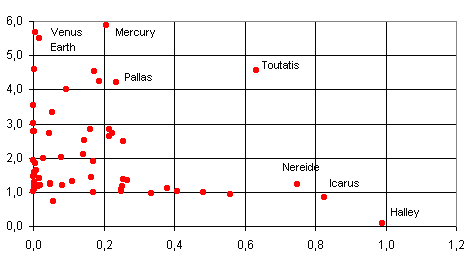
Fig. 3. The distribution of density of celestial bodies on orbit eccentricity.
From this diagram it is completely visible, that with falling of an eccentricity of orbit of cometary bodies their density grows. That is with increase of age of a comet the gases and other light materials with low temperature of boiling volatizate from it. As the exhaust velocity of jets of these materials in vacuo practically is equal to a speed of sound for temperature of a boiling / sublimation, their jet efficiency for a decrease of an eccentricity of orbit is very high.
Obviously, that planetary satellites having density lower than 2 [kg/dm3], are cometary nuclei, expended a light constituent. Such satellites are majority of celestial bodies.
In a fig. 4. the distribution of mass of celestial bodies and their density is shown.
This diagram also is clear displays evolution of cometary bodies from young comets to satellites of the Jovian type planets both accretion them and interstellar gas-dust mix on Jovian type planets (blue punches).
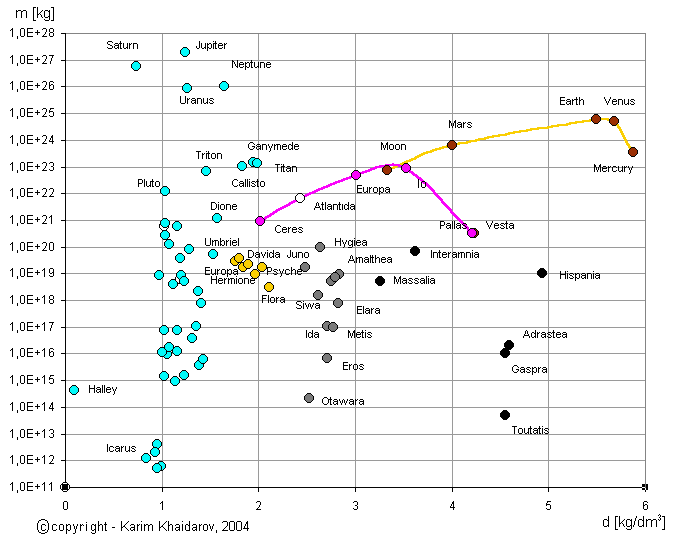
Fig. 4. The distribution of mass and density of 80 celestial bodies of a Solar system
(+ one empty punch - the hypothetical celestial body Atlantida).
The nuclei of old comets, entrapped by niche of asteroid belt (yellow punches) stay in separate cluster. Except them there are two large clusters, which are considered as chondrites (grey punches) and iron-stony asteroids (black punches). Asteroidal bodies of two last clusters, by photos, are debrises of a large planetary body.
The analysis of orbits of asteroids conducted by many astronomers displays, that asteroids could not be outcome of a single act of destruction of a planetary body.
The expended volatiles comets have received stable orbits in the asteroid belt, free from a planet an orbital niche. The absence of a planetary disturbance allows to exist them practically eternally on personal orbits. They came in Solar system from different directions, therefore their trajectories in any way are not connected.
However between “heavy”, that is is planetary - fragmentational asteroids there is a genetical connection. Here it is possible to point presence in the past of the main collision and several derived collisions, which have grown out of that the same orbital niche was held at once by many celestial bodies. Their collision early or late should take place.
For detection of the particular script of main disastrous event in the asteroid belt we will return on 4.6 billion of years back and we shall consider two planetary systems, which participat in this space event.
Planetary System of a White Dwarf
In spite of strangeness, according to author’s calculation the Solar system more than 4.6 billions (4.6·109) years ago was a planetary system consisting of Jovian type planets (protoplanets), rotated around of a white dwarf.
While it is difficult to say how much billions of years this system existed, but about its structure, the parameters of masses we can reason precisely.
Outgoing from regularities of accumulation of material by protoplanets, shown above, the author retrieved distribution of gaseous masses (atmospheres) and solid cores (pure masses of planets), and also densities of their solid part. The results of simulation are shown in the table 1 and on a histogram on fig. 5.
Table 1. Parameters of Solar system 4.6 billion of years ago
|
N |
R |
M (H-He) |
M (solid) |
D [kg/dm3] |
|
|
Old Sun |
0 |
0 |
1,8E+23 |
1,81E+30 |
30000 |
|
Mercury |
1 |
1 |
1,65E+25 |
3,30E+23 |
5,454 |
|
Venus |
2 |
1,75 |
2,43E+26 |
4,87E+24 |
4,814 |
|
Earth |
3 |
2,5 |
2,99E+26 |
5,97E+24 |
4,249 |
|
Mars |
4 |
4 |
9,95E+25 |
6,64E+23 |
3,750 |
|
Moon |
5 |
7 |
3,32E+25 |
7,37E+22 |
3,310 |
|
Jupiter |
6 |
13 |
1,11E+25 |
8,19E+21 |
2,870 |
|
Saturn |
7 |
25 |
3,69E+24 |
9,10E+20 |
2,488 |
|
Uranus |
8 |
49 |
1,23E+24 |
1,01E+20 |
2,157 |
|
Neptune |
9 |
97 |
4,10E+23 |
1,12E+19 |
1,870 |
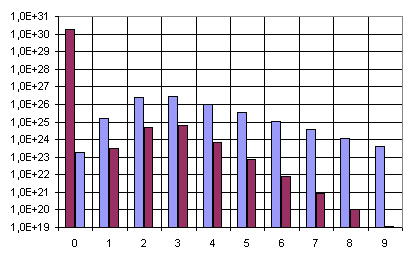
Fig. 5. A histogram of mass distribution of atmospheres (blue columns)
and solid cores (brown columns) of planets of Solar system 4.6 billion years ago
( 0 - Sun, 1 - Mercury, 2 - Venus, 3 - Earth, 4 - Mars, 5 - Moon, 6 - Jupiter, 7 - Saturn, 8 - Uranus)
From weak influence of solar radiation to formation of short-range planets and fact of existence in that time of the same planetary niches (which have not collapsed and have not changed after catastrophe) uniquely follows, that the Sun in that epoch was a white dwarf practically with same weight, as modern Sun. The difference was only in a phase condition of solar material, which was in metasolid condition, oblate by gravitation to density about 30 ton/dm3.
All planets of that time (the author considers, that they were 8, and fifth from the Sun was Moon) had hydrogen-helium-methane atmosphere and were typical Jovian type planets. The modern density of the indicated celestial bodies uniquely bear for the benefit of offered model.
The ratio of density and chemical content on heavy (Pb) and volatile heavy (Hg) materials of internal planets and Moon confirms the offered model [19].
Planetary System of an Infrared Dwarf
Developing a hypothesis of Heinrich Wilhelm Olbers we will try to explain the origin of a present Solar system with its two types of planets and asteroidal belt, having assumed, that apart 2.8 a.u. from the Sun there was a collision of a celestial body Phaeton with one planet of a Solar system.
In the difference of Olbers’s hypothesis, after the conducted research, it is appears to the author, that Phaeton was a protostar - an infrared dwarf, having a mass one hundred times smaller than Sun.
After the analysis of masses, densities and parameters of orbits, contents of chemical units in rocks of celestial bodies and cometary-stellar evolution described above, the author has come to following model of Phaeton planetary system, which disastrously has confronted with one of planets of Solar system.
The outcomes of simulation are shown in the table 2 and on a histogram fig. 6.
Table 2. Parameters of Phaeton planetary system 4.6 billion years ago
|
N |
R |
M (H-He) |
M (solid) |
D [kg/dm3] |
|
|
Phaeton |
0 |
0 |
1,48E+28 |
2,96E+26 |
1880 |
|
Vesta/Pallas |
1 |
1 |
1,59E+22 |
3,18E+20 |
4,210 |
|
Io |
2 |
1,75 |
7,32E+24 |
8,93E+22 |
3,507 |
|
Europa |
3 |
2,5 |
2,44E+24 |
4,88E+22 |
2,921 |
|
Atlantida (?) |
4 |
4 |
8,14E+23 |
6,51E+21 |
2,433 |
|
Ceres |
5 |
7 |
2,71E+23 |
8,68E+20 |
2,027 |
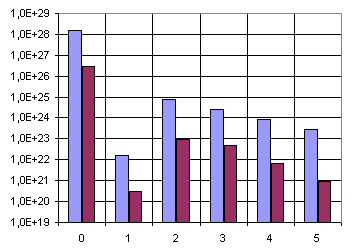
Fig. 6. A histogram of mass distribution of atmospheres (blue columns)
and solid cores (brown columns) of planets of Phaeton system 4.6 billion years ago
( 0 - Phaeton, 1 - Vesta/Pallas, 2 - Io, 3 - Europa, 4 - Atlantida, 5 - Ceres)
The Phaeton planetary system consist of Jovian-type planets. The solid cores of these planets exist till now (excepting Atlantida planet) and are known under the same titles as asteroids and satellites of Jupiter.
The modern density of the indicated celestial bodies uniquely bear that the evolution of this planetary system were more short, rather than of Solar system before disastrous collision at 4.6 billion years ago. This one more confirmation of the Titius-Bode concept.
The Meeting of Two Planetary Systems
As a diameter of a typical planetary system (gravitational pit of a star) is thousands a.u., and the stars are almost on each parsec, apparently, the meeting of two planetary systems is not so infrequent Space event.
The collision of celestial bodies of different planetary systems is indeed infrequent. However such event has taken place 4.56·109 years ago.
By results of research of the author the Phaeton planetary system has approached to center of Solar system towards motion of Sun planets.
The own trajectory of Phaeton has intercrossed dense atmosphere of the fifth planet of Solar system. At that time it was Moon.
As a result of the shock wave which has arisen in lunar atmosphere, Moon was braked from 18 km/c of the orbital speed down to 13 - 15 km/s and has changed a direction of movement. The consequence of this impact has remained for ever. The modern figure of moon is a similarity of “an apple” with large, more than Moon’s radius, dent in a southern hemisphere (nowadays the back side of Moon).
Having received such momentum moon has left from orbit and during halfcycle of the reversal was lowered almost down to orbit of Venus, and then has rised up to orbit of the Earth, where was grasped by Earth’s gravitational pit and became a satellite of our planet.
Practically head-on collision of two atmospheres – Phaeton’s and Moon’s has changed a direction of movement of gaseous masses, having dispersed both atmospheres. Being outside of the atmosphere the solid part of Phaeton, which considerable part was in oblate metasolid phase state, was blasted from within, having deprived compensatory pressure of a atmospheric gas.
The fragments of that indeed giant Space explosion have destroyed one of Phaeton’s planet – Atlantida (necessity of its existence follows from the author’s evaluation).
At the moment of these fragments arrival of a solid surface of Moon, it already was in time to turn by another side, and nowadays we see, that the distribution of craters on a surface of Moon has equally two hemispherical clusters. It is possible to say the same about Mars which was on the path of motion of these fragments. Exactly the half of Martian surface (also in a southern hemisphere) rugged by craters (see fig. 7). This is a known problem of Martian dichotomy, revealing the reasons of which there are many scientific works, for example, see [24,25] By our opinion, closer than others, to decision of given problem E.V. Dmitriev has coming, who offered model of the one-shot bombing of Martian surface through deep atmosphere [21-23].
The planets of Phaeton system, having deprived the center of gravity at the moment of Phaeton explosion, have formed together with Phaeton’s fragments the asteroidal belt. Io and Europa were grasped by gravitation of Jupiter and became its satellites.
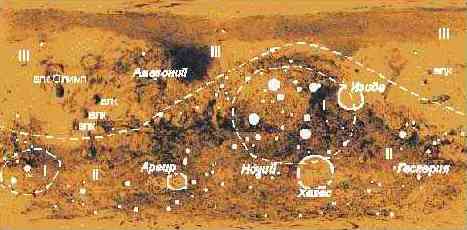
Fig. 7. The Matian Map. The division of surface on two hemispheres,
greatly differently damaged of meteorites bombing [26, 27].
The Sun - Nova
However, the most essential consequence of collision has taken place as a result of falling Phaeton fragments on the Sun.
They have caused disturbance of a fragile phase equilibrium and explosion of metasolid core of a white dwarf. Being before in a stable oblate state metasolid core of a white dwarf, which physics is described by the author in [15], sharply has freed elastic energy and hydrogen and helium contained in it. There was an explosion of a nova star. Such explosions are annually observed by astronomers in the Universe.
The power of solar radiation has increased approximately in a 2000 times. The flow of neutrons (hydrogen in metasolid state) and protons - the product of their decay was increased in million times. The gaseous atmospheres of planets and thin solid surface have evaporated. In time about one year the main part of energy of substantional phase transition “metasolid state - gas” on the Sun was expended for radiation. The process of condensation evaporated material onto surfaces of the escaped celestial bodies has begun. From that time there were meteoritic and surface planetary rocks such chondrites - condensed drops of nonvolatile in usual conditions materials (see fig. 8).

Fig. 8. Chondrites - condensed droplets of solid material, vaporized by the blast of nova star,
witnesses of the catastrophe 4.56·109 years ago. The photomicrography.
Investigating dropped out on the surface of the Earth chondrite meteorites it is possible to see their precise clusterization on a degree of iron oxidation (see fig. 7) [20]. Knowing, that iron reduction level from oxides precisely depends on density of protons, that is sedimental body proximity to the Sun, it is easy to identify an origin of meteorites of each cluster. Most oxidate carbonaceous chondrites belong to former atmosphere of Moon (as 5-th planet), further - cluster of protoatmosphere of Mars, further - “the ordinary chondrites”, that is bodies of secondary condensation of Earth’s protoatmosphere, further - Venus, and, at last, - enstatite chondrites of a Mercury with completely reducted iron.
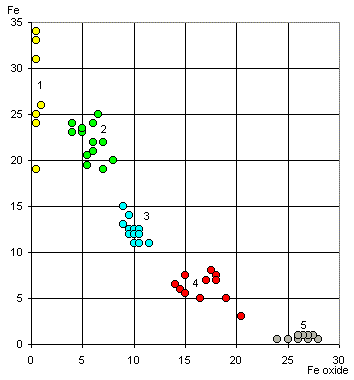
Fig. 9. A ratio of iron oxidation in chondrite meteorites [A. Ringwood, 20]
(1 – enstatite chondrites (proto-Mercury), 2 - H-chondrites (proto-Venus), 3 - L-chondrites (proto-Earth),
4 – C2-chondrites (proto-Mars), 5 - C1-chondrites (proto-Moon))
Thus, after explosion of Sun - nova star, 4560 millions years ago the formation of modern distribution and content of planetary atmospheres began (see table 3 and fig. 10).
The table 3. The computational parameters of a modern Solar system
|
N |
R |
M (atm) |
M (solid) |
D [kg/dm3] |
|
Postnova Sun |
0 |
0 |
1,989E+30 |
2,76E+27 |
29000 |
|
Mercury |
1 |
1 |
1,00E+13 |
3,30E+23 |
5,454 |
|
Venus |
2 |
1,75 |
1,00E+20 |
4,87E+24 |
4,814 |
|
Earth |
3 |
2,5 |
1,00E+18 |
5,97E+24 |
4,249 |
|
Mars |
4 |
4 |
1,00E+16 |
6,63E+23 |
3,750 |
|
Asteroids |
5 |
7 |
1,00E+12 |
3,00E+21 |
2 - 4 |
|
Jupiter |
6 |
13 |
2,73E+27 |
8,19E+21 |
2,870 |
|
Saturn |
7 |
25 |
9,09E+26 |
9,10E+20 |
2,488 |
|
Uranus |
8 |
49 |
3,03E+26 |
1,01E+20 |
2,157 |
|
Neptune |
9 |
97 |
1,01E+26 |
1,12E+19 |
1,870 |
|
Pluto |
10 |
193 |
3,37E+25 |
1,25E+18 |
1,040 |
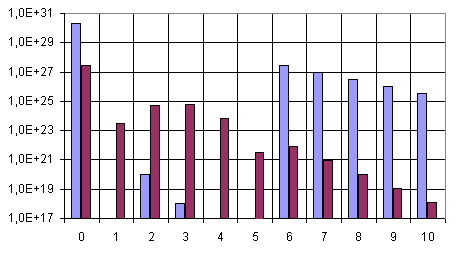
Fig. 10. A histogram of modern mass distribution of atmospheres (blue columns)
and solid cores (brown columns) of Solar system planets.
For formation of powerful hydrogen-helium atmospheres of internal planets the barrier as powerful radiation of the Sun superior on two order radiation of a white dwarf has appeared. Besides the powerful flow of protons from the Sun exhausted its kinetic energy in region of Jupiter - Saturn, mostely sedimenting on them as hydrogen.
Conclusions
As a result of the research, made by the author, the following reasons of present look of Universe and Solar system are clarified
References
Karim Khaidarov
Almaty, November 5, 2004.